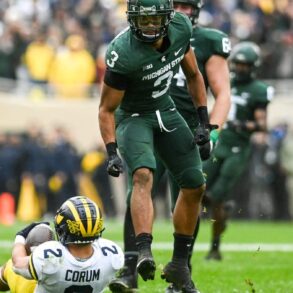Tony’s takes: My three-step plan to save college football
If Nick Saban is truly college football’s knight in shining armor, this will be his biggest feat of heroics yet. Earlier this week, Saban and Texas Tech board of regents chairman Cody Campbell were chosen to co-chair President Donald Trump’s commission on college athletics.
The new commission is expected to examine the landscape of college sports and work toward fixing issues including booster-funded payments, transfer rules, conference alignment and Title IX. On paper, Saban — college football’s best-ever head coach — and Campbell — a former Texas Tech football player turned multi-billionaire businessman — appear to be promising choices for leadership.
I can’t say I’m confident the duo can save the sanctity of college football, but I can tell you the steps I would take if I were in their shoes. With that said, here is my three-step process to saving the sport.
Advertisement
Create a single transfer window
This is the most popular suggestion when it comes to fixing college football. Simply put, the spring transfer window is a mess. Most of the high-impact transfers are handled in the winter window, and having a 10-day transfer period following spring camp only leads to chaos and roster uncertainty.
A singular transfer window is a must, but with every solution comes a compromise. Currently, players have a 20-day transfer window in the winter followed by a 10-day period in the spring. My compromise is creating a single three-month window that begins on Jan. 1 and extends until March 31.
That’s an 89-day period compared to the combined 30 days players currently get. My timeline comes with a catch, but we’ll get to that later.
This is a win-win for both parties. Prospective transfers would have an extended amount of time to settle on a new destination, while teams would be able to finalize their rosters in time for spring camp.
Who knows, maybe this could revive Alabama’s A-Day game… provided we all pay a small contribution to Yea Alabama, of course.
Impose a roster-transaction window
Remember how I said my extended window comes with a catch? Well, here it is. While my model would give players an extended period to find a new home, it would impose a deadline for them to sign with a new school.
Players would have until March 31 to register with a new school for the coming season. Any unregistered player after that date would be eligible to sign and receive money from a school but would not be able to play until the beginning of the following window.
In addition, players who register with a team would not be eligible to re-register with another team in the same season. For example, if a player decided to transfer from his team in October, he could join a playoff team in January. Theoretically, an unregistered player could wait until January to join a playoff team. However, that scenario would be highly unlikely.
I’m even fine with early enrollees becoming immediately eligible for playoff teams provided those incoming freshmen elect to use their redshirt season in order to play in those games. Consider it an added recruiting benefit for contending teams.
Allow binding NIL contracts
While the above transfer alterations should help, things would be a lot easier if teams would be allowed to sign players to binding deals. That could soon become possible due to a multibillion-dollar antitrust case that would allow schools to pay athletes a portion of their media revenues, capped at $20.5 million per season, starting on July 1.
There’s still concern over how such a ruling would create a divide between the haves and have-nots of the sport. Wealthier teams would still have a distinct advantage, as they would be able to pool their NIL funds along with expected media revenue. However, at the very least, we might see an end to the continuous jumping of ship among players vying for more lucrative offers on a yearly basis.
As is the case with coaches, such contracts could come with buy-out clauses. That could create some interesting transfer situations. Say Alabama wanted to poach a star freshman from Auburn who had signed a three-year deal with the Tigers. Assuming that player had a buy-out clause, Alabama would pay Auburn that said fee, which the Tigers would be able to use on another transfer to fill the hole in their roster.
This isn’t a perfect fix, but it’s more realistic than creating any type of salary cap. Outside of the $20.5 million per season allowed in revenue sharing, the ambiguity of NIL makes it impossible to regulate how much money teams can promise players. There will always be a disparity between college football’s biggest programs. However, the introduction of contracts will at least bring some structure to what has become a chaotic landscape.

Drink of the week — Old Fashioned
I brainstormed my college football fixes over a few Old Fashioneds with a friend on Saturday night, so it’s only fitting that the cocktail should be our drink of the week.
No one makes a better Old Fashioned in Tuscaloosa than our friends at Session Cocktails. Here’s how they stir up the classic drink.
Combine two ounces of Old Forester bourbon (head coach Paul “Bear” Bryant’s favorite), .25 ounces of Demerara Syrup and three dashes of Angostura Bitters. Pour the ingredients into a glass, add ice and stir. Express an orange peel over the drink and rub it around the rim before placing it in the glass. Express a lemon peel over the drink before placing it in the glass as well.
Cheers!
(Commercial break: My drink of the week section is now sponsored by my friends at Session Cocktails in Tuscaloosa. Session has been a mainstay in Tuscaloosa’s cocktail scene since 2019 and offers some of the tastiest drinks in town. Stop by and tell them I said hi!)
This post was originally published on this site be sure to check out more of their content.









